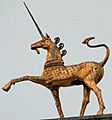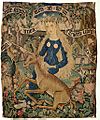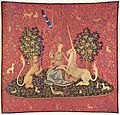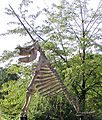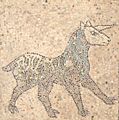Unicorn facts for kids
A unicorn is a special creature from old stories and myths. It looks like a horse, but it has one long, white horn on its forehead. The name "unicorn" means "one horn." It comes from the Latin words ūnus (one) and cornu (horn).

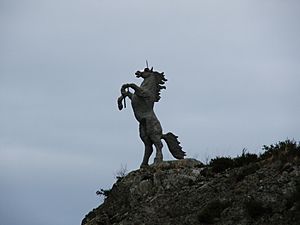
Unicorns are found in many stories and myths. These tales come from different places, especially China and India. In these stories, a unicorn's blood and horn often have special, magical powers.
Contents
Unicorn Powers and Symbols
In Western culture, the unicorn's horn is said to have amazing powers. This horn is sometimes called alicorn in old books. It is believed to heal injuries and sickness. It can also make poisons harmless.
In myths and symbols, the unicorn stands for innocence and purity. It also represents feminine power. People often see it as the opposite of a lion. The lion usually stands for masculine strengths.
The unicorn is the official animal of Scotland. This means it is a special symbol for the country.
What Do Unicorns Look Like?
In some pictures, unicorns have horse feet. Other times, they might have a lion's tail. Most often, they look like a beautiful white horse with a single horn.
Unicorns in History
Christian legends say that unicorns are as small as a normal goat. They are also said to be very shy. No hunter can ever catch them. Only a young, pure maiden who goes into the forest alone can attract a unicorn. The unicorn will then come and fall asleep in her lap.
Around the Middle Ages, stories about unicorns became very popular. More people wanted to learn about them. Even just seeing a picture of a unicorn was exciting. Rich people, like kings and queens, bought what they thought were unicorn horns. They paid very high prices for them. However, these "horns" were usually just tusks from a walrus or a horn from a narwhal.
Real-Life "Unicorns"
A Narwhal is a real animal that lives in the ocean. It is a type of whale, about 8 feet long. Narwhals live in the cold waters around Canada and Greenland. Male narwhals have a very long, straight tusk that looks like a horn.
In the past, some people claimed that narwhal tusks were the horns of unicorns. They would sell these tusks to others, saying they were real unicorn horns. This was a way to trick people into buying something very expensive.
The word "unicorn" is also used today in business. It refers to a new business startup company. This company must be worth a billion dollars or more.
Images for kids
-
Gilt statue of a unicorn on the Council House, Bristol
-
Youths riding goats on 12th-century carvings from the Mozac Abbey in Auvergne. These goats look very much like unicorns.
-
An 18th-century unicorn on an old pharmacy in Flensburg.
-
Maiden with Unicorn, a tapestry from the 15th century (Musée de Cluny, Paris).
-
The Unicorn Is Penned, one of the Unicorn Tapestries, from around 1495–1505 (The Cloisters, Metropolitan Museum of Art, New York City).
-
The unicorn throne in Denmark.
-
Otto von Guericke's unicorn skeleton, on display near the Zoo in Osnabrück.
-
Indus Valley seals showing 'unicorns' (British Museum).
-
A model of the elasmotherium, an ancient rhino that had one large horn.
-
A male narwhal with its long tusk.
-
A one-horned oryx.
-
The eland.
-
A painting of an aurochs, an extinct type of wild cattle.
See also
 In Spanish: Unicornio para niños
In Spanish: Unicornio para niños




